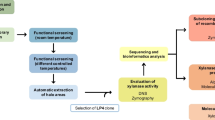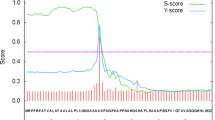Abstract
Xylanase is efficient for xylan degradation and widely applied in industries. We found a GH11 family xylanase (Xyn11A) with high thermostability and catalytic activity from compost metatranscriptome. This xylanase has the optimal reaction temperature at 80 °C with the activity of 2907.3 U/mg. The X-ray crystallographic structure shows a typical “right hand” architecture, which is the characteristics of the GH11 family enzymes. Comparing it with the mesophilic XYN II, a well-studied GH11 xylanase from Trichoderma reesei, Xyn11A is more compact with more H-bonds. Our mutagenic results show that the electrostatic interactions in the thumb and palm region of Xyn11A could result in its high thermostability and activity. Introducing a disulfide bond at the N-terminus further increased its optimal reaction temperature to 90 °C with augmented activity.
Key points
• A hyperthermophilic xylanase with high activity was discovered using the metatranscriptomic method.
• The mechanisms of thermophilicity and high activity were revealed using X-ray crystallography, mutagenesis, and molecular dynamics simulations.
• The thermostability and activity were further improved by introducing a disulfide bond.





Similar content being viewed by others
Data availability
All data generated or analyzed during this study are included in this manuscript (and its supplementary information).
References
Altschul SF, Madden TL, Schaffer AA, Zhang J, Zhang Z, Miller W, Lipman DJ (1997) Gapped BLAST and PSI-BLAST: a new generation of protein database search programs. Nucleic Acids Res 25(17):3389–3402. https://doi.org/10.1093/nar/25.17.3389
An FY, Li M, Zhao Y, Zhang Y, Mu DL, Hu XY, You SB, Wu JR, Wu RN (2021) Metatranscriptome-based investigation of flavor-producing core microbiota in different fermentation stages of dajiang, a traditional fermented soybean paste of Northeast China. Food Chem 343:128509–128517. https://doi.org/10.1016/j.foodchem.2020.128509
Antunes LP, Martins LF, Pereira RV, Thomas AM, Barbosa D, Lemos LN, Silva GMM, Moura LMS, Epamino GWC, Digiampietri LA, Lombardi KC, Ramos PL, Quaggio RB, de Oliveira JCF, Pascon RC, da Cruz JB, da Silva AM, Setubal JC (2016) Microbial community structure and dynamics in thermophilic composting viewed through metagenomics and metatranscriptomics. Sci Rep 6:38915–38927. https://doi.org/10.1038/srep38915
Argos P, Rossman MG, Grau UM, Zuber H, Frank G, Tratschin JD (1979) Thermal stability and protein structure. Biochemistry 18(25):5698–5703. https://doi.org/10.1021/bi00592a028
Barlow DJ, Thornton JM (1983) Ion-pairs in proteins. J Mol Biol 168(4):867–885. https://doi.org/10.1016/s0022-2836(83)80079-5
Bornhorst JA, Falke JJ (2000) Purification of proteins using polyhistidine affinity tags. Meth Enzymol 326:245–254. https://doi.org/10.1016/s0076-6879(00)26058-8
Chen SW, Pellequer JL (2013) Adepth: new representation and its implications for atomic depths of macromolecules. Nucleic Acids Res 41(Web Server issue):W412–W416. https://doi.org/10.1093/nar/gkt299
Chen VB, Arendall WB 3rd, Headd JJ, Keedy DA, Immormino RM, Kapral GJ, Murray LW, Richardson JS, Richardson DC (2010) MolProbity: all-atom structure validation for macromolecular crystallography. Acta Crystallogr D Biol Crystallogr 66(Pt 1):12–21. https://doi.org/10.1107/S0907444909042073
Collins T, Gerday C, Feller G (2005) Xylanases, xylanase families and extremophilic xylanases. FEMS Microbiol Rev 29(1):3–23. https://doi.org/10.1016/j.femsre.2004.06.005
Darden T, York D, Pedersen L (1993) Particle mesh Ewald: An N⋅log(N) method for Ewald sums in large systems. J Chem Phys 98(12):10089–10092. https://doi.org/10.1063/1.464397
Emsley P, Lohkamp B, Scott WG, Cowtan K (2010) Features and development of Coot. Acta Crystallogr D Biol Crystallogr 66(Pt 4):486–501. https://doi.org/10.1107/S0907444910007493
Haki GD, Rakshit SK (2003) Developments in industrially important thermostable enzymes: a review. Bioresour Technol 89(1):17–34. https://doi.org/10.1016/s0960-8524(03)00033-6
Hakulinen N, Turunen O, Janis J, Leisola M, Rouvinen J (2003) Three-dimensional structures of thermophilic beta-1,4-xylanases from Chaetomium thermophilum and Nonomuraea flexuosa. Comparison of twelve xylanases in relation to their thermal stability. Eur J Biochem 270(7):1399–1412. https://doi.org/10.1046/j.1432-1033.2003.03496.x
Hess B, Bekker H, Berendsen HJC, Fraaije JGEM (1997) LINCS: a linear constraint solver for molecular simulations. J Comput Chem 18(12):1463–1472. https://doi.org/10.1002/(SICI)1096-987X(199709)18:12%3c1463::AID-JCC4%3e3.0.CO;2-H
Hu ZH, Liu SY, Yue ZB, Yan LF, Yang MT, Yu HQ (2008) Microscale analysis of in vitro anaerobic degradation of lignocellulosic wastes by rumen microorganisms. Environ Sci Technol 42(1):276–281. https://doi.org/10.1021/es071915h
Jaenicke R, Schurig H, Beaucamp N, Ostendorp R (1996) Structure and stability of hyperstable proteins: glycolytic enzymes from hyperthermophilic bacterium Thermotoga maritima. Adv Protein Chem 48:181–269. https://doi.org/10.1016/s0065-3233(08)60363-0
Kumar S, Tamura K, Nei M (1994) MEGA: Molecular Evolutionary Genetics Analysis software for microcomputers. Comput Appl Biosci 10(2):189–191. https://doi.org/10.1093/bioinformatics/10.2.189
Kumar S, Tsai CJ, Nussinov R (2000) Factors enhancing protein thermostability. Protein Eng 13(3):179–191. https://doi.org/10.1093/protein/13.3.179
Li ZH, Zhang XS, Wang QQ, Li CR, Zhang NY, Zhang XK, Xu BR, Ma BL, Schrader TE, Coates L, Kovalevsky A, Huang YD, Wan Q (2018) Understanding the pH-dependent reaction mechanism of a glycoside hydrolase using high-resolution X-ray and neutron crystallography. ACS Catal 8(9):8058–8069. https://doi.org/10.1021/acscatal.8b01472
Mamo G, Thunnissen M, Hatti-Kaul R, Mattiasson B (2009) An alkaline active xylanase: Insights into mechanisms of high pH catalytic adaptation. Biochimie 91(9):1187–1196. https://doi.org/10.1016/j.biochi.2009.06.017
Marneth K, van den Elst H, Cramer-Blok A, Codee J, Overkleeft HS, Aerts J, Ubbink M, Ben Bdira F (2021) Tuning the transglycosylation reaction of a GH11 xylanase by a delicate enhancement of its thumb flexibility. Chembiochem 22(10):1743–1749. https://doi.org/10.1002/cbic.202000856
Meng DD, Ying Y, Chen XH, Lu M, Ning K, Wang LS, Li FL (2015) Distinct roles for carbohydrate-binding modules of glycoside hydrolase 10 (GH10) and GH11 xylanases from Caldicellulosiruptor sp. strain F32 in thermostability and catalytic efficiency. Appl Environ 81(6):2006–2014. https://doi.org/10.1128/AEM.03677-14
Minor W, Cymborowski M, Otwinowski Z, Chruszcz M (2006) HKL-3000: the integration of data reduction and structure solution–from diffraction images to an initial model in minutes. Acta Crystallogr D Biol Crystallogr 62(Pt 8):859–866. https://doi.org/10.1107/S0907444906019949
Mukhopadhyay R, Talipov MR (2020) Efficient newton-raphson/singular value decomposition-based optimization scheme with dynamically updated critical condition number for rapid convergence of weighted histogram analysis method equations. J Comput Chem 41(3):240–246. https://doi.org/10.1002/jcc.26094
Murshudov GN, Vagin AA, Dodson EJ (1997) Refinement of macromolecular structures by the maximum-likelihood method. Acta Crystallogr D Biol Crystallogr 53(Pt 3):240–255. https://doi.org/10.1107/S0907444996012255
Nielsen H, Tsirigos KD, Brunak S, von Heijne G (2019) A brief history of protein sorting prediction. Protein J 38(3):200–216. https://doi.org/10.1007/s10930-019-09838-3
Niu SY, Yang J, McDermaid A, Zhao J, Kang Y, Ma Q (2018) Bioinformatics tools for quantitative and functional metagenome and metatranscriptome data analysis in microbes. Brief Bioinformatics 19(2):360–374. https://doi.org/10.1093/bib/bby012
Paes G, Berrin JG, Beaugrand J (2012) GH11 xylanases: structure/function/properties relationships and applications. Biotechnol Adv 30(3):564–592. https://doi.org/10.1016/j.biotechadv.2011.10.003
Páll S, Abraham MJ, Kutzner C, Hess B, Lindahl E (2015) Tackling exascale software challenges in molecular dynamics simulations with GROMACS. In: Markidis S, Laure E (eds) Solving Software Challenges for Exascale, vol 8759. Springer, Cham, pp 3–27. https://doi.org/10.1007/978-3-319-15976-8_1
Pollet A, Vandermarliere E, Lammertyn J, Strelkov SV, Delcour JA, Courtin CM (2009) Crystallographic and activity-based evidence for thumb flexibility and its relevance in glycoside hydrolase family 11 xylanases. Proteins 77(2):395–403. https://doi.org/10.1002/prot.22445
Robert X, Gouet P (2014) Deciphering key features in protein structures with the new ENDscript server. Nucleic Acids Res 42(Web Server issue):W320-324. https://doi.org/10.1093/nar/gku316
Tang F, Chen DW, Yu B, Luo YH, Zheng P, Mao XB, Yu J, He J (2017) Improving the thermostability of Trichoderma reesei xylanase 2 by introducing disulfide bonds. Electron J Biotechnol 26:52–59. https://doi.org/10.1016/j.ejbt.2017.01.001
Torronen A, Harkki A, Rouvinen J (1994) Three-dimensional structure of endo-1,4-beta-xylanase II from Trichoderma reesei: two conformational states in the active site. EMBO J 13(11):2493–2501. https://doi.org/10.1002/j.1460-2075.1994.tb06536.x
Tuomela M, Hatakka A, Raiskila S, Vikman M, Itavaara M (2001) Biodegradation of radiolabelled synthetic lignin (14C-DHP) and mechanical pulp in a compost environment. Appl Microbiol Biotechnol 55(4):492–499. https://doi.org/10.1007/s002530000513
Vagin A, Teplyakov A (1997) MOLREP: an automated program for molecular replacement. J Appl Crystallogr 30:1022–1025. https://doi.org/10.1107/S0021889897006766
Verma D, Kawarabayasi Y, Miyazaki K, Satyanarayana T (2013) Cloning, expression and characteristics of a novel alkalistable and thermostable xylanase encoding gene (Mxyl) retrieved from compost-soil metagenome. PLoS ONE 8(1):e52459-52466. https://doi.org/10.1371/journal.pone.0052459
Wakarchuk WW, Campbell RL, Sung WL, Davoodi J, Yaguchi M (1994) Mutational and crystallographic analyses of the active-site residues of the Bacillus-circulans xylanase. Protein Sci 3(3):467–475. https://doi.org/10.1002/pro.5560030312
Wallace AC, Laskowski RA, Thornton JM (1995) LIGPLOT: a program to generate schematic diagrams of protein-ligand interactions. Protein Eng 8(2):127–134. https://doi.org/10.1093/protein/8.2.127
Winn MD, Ballard CC, Cowtan KD, Dodson EJ, Emsley P, Evans PR, Keegan RM, Krissinel EB, Leslie AG, McCoy A, McNicholas SJ, Murshudov GN, Pannu NS, Potterton EA, Powell HR, Read RJ, Vagin A, Wilson KS (2011) Overview of the CCP4 suite and current developments. Acta Crystallogr D Biol Crystallogr 67(Pt 4):235–242. https://doi.org/10.1107/S0907444910045749
Zeng G, Zhang L, Dong H, Chen Y, Zhang J, Zhu Y, Yuan Y, Xie Y, Fang W (2018) Pathway and mechanism of nitrogen transformation during composting: functional enzymes and genes under different concentrations of PVP-AgNPs. Bioresour Technol 253:112–120. https://doi.org/10.1016/j.biortech.2017.12.095
Zhang S, Zhang K, Chen X, Chu X, Sun F, Dong Z (2010) Five mutations in N-terminus confer thermostability on mesophilic xylanase. Biochem Biophys Res Commun 395(2):200–206. https://doi.org/10.1016/j.bbrc.2010.03.159
Zhang J, Siika-Aho M, Puranen T, Tang M, Tenkanen M, Viikari L (2011) Thermostable recombinant xylanases from Nonomuraea flexuosa and Thermoascus aurantiacus show distinct properties in the hydrolysis of xylans and pretreated wheat straw. Biotechnol Biofuels 4:12–24. https://doi.org/10.1186/1754-6834-4-12
Zheng HC, Liu YH, Sun MZ, Han Y, Wang JL, Sun JS, Lu FP (2014) Improvement of alkali stability and thermostability of Paenibacillus campinasensis Family-11 xylanase by directed evolution and site-directed mutagenesis. J Ind Microbiol Biotechnol 41(1):153–162. https://doi.org/10.1007/s10295-013-1363-6
Acknowledgements
Research at ORNL’s Spallation Neutron Source was sponsored by the Scientific User Facilities Division, Office of Basic Energy Sciences, US Department of Energy. We thank the SSRF beamlines BL18U1 and BL19U1 for X-ray data collection.
Funding
Q.W. was supported by the National Natural Science Foundation of China (Nos. 31670790 and 32071264) and the Fundamental Research Funds for the Central Universities (No. KYXK202009).
Author information
Authors and Affiliations
Contributions
YY conducted the experiments and wrote the manuscript. SX solved the crystallographic structure. AK revised the manuscript. XZ helped protein expression. DL helped bioinformatic studies. QW supervised the research and revised the manuscript. All authors read and approved the final manuscript.
Corresponding author
Ethics declarations
Ethical approval
This article does not contain any studies with human participants or animals performed by any of the authors.
Conflict of interest
The authors declare no competing interests.
Additional information
Publisher's note
Springer Nature remains neutral with regard to jurisdictional claims in published maps and institutional affiliations.
Supplementary Information
Below is the link to the electronic supplementary material.
Rights and permissions
About this article
Cite this article
Yi, Y., Xu, S., Kovalevsky, A. et al. Characterization and structural analysis of a thermophilic GH11 xylanase from compost metatranscriptome. Appl Microbiol Biotechnol 105, 7757–7767 (2021). https://doi.org/10.1007/s00253-021-11587-2
Received:
Revised:
Accepted:
Published:
Issue Date:
DOI: https://doi.org/10.1007/s00253-021-11587-2




